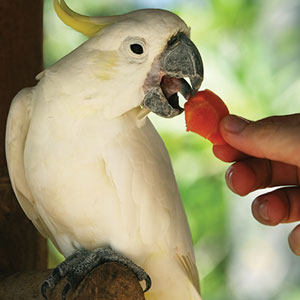
How to Train a Bird Using Positive Reinforcement
Positive reinforcement is a technique that teachers often use to modify children's behavior by reinforcing desired behaviors. But did you know that you can and should use positive reinforcement with your bird? Positive reinforcement is the key to successful training. Positive reinforcement includes rewarding good behavior and ignoring bad behavior. If you communicate clearly and consistently with your bird, you can encourage and increase desired behavior, while discouraging and hopefully stopping bad behavior.
Positively Reinforce Desired Behavior
Positive reinforcement includes giving your bird something that he enjoys or wants. This could include a treat, toy, cuddle, or other simple interactions, such as laughing, verbal praise, yelling, or making eye contact. Rewards should be given consistently and quickly so that your bird associates the reward with the desired behavior or action. If your bird starts repeating a behavior, you have successfully positively reinforced that behavior.Try to establish short training sessions (2 to 3 minutes) into your daily routine, and do your best to end every training session on a positive note. While training with your bird, you should always be aware of his actions and your own reactions.
Positive reinforcement increases the bond between you and your bird. It can help build trust between the two of you, and it also helps you to understand his body language.
Tip: Make sure that your reward is actually positive. Birds are different, and they like different things.
Ignore Bad Behavior
Unfortunately, it is very easy to reinforce bad behavior on accident. It is important to ignore bad behavior, or there is a good chance that it will continue. If you give your bird a lot of attention when he vocalizes loudly or screams, he will continue to do this because he is receiving the attention that he craves. Another suggestion to stop bad behavior is to replace the bad behavior with a desired behavior. For example, if your bird repeats a bad word, teach him a new word to replace the bad word. You should never use aggression or punishment towards your bird.Outcome: Established Boundaries
Your bird will decide which behaviors to continue based on your reactions and interactions. If you reward desired behavior with a treat or praise and ignore bad behavior, you will establish boundaries that your bird will recognize.If you work on rewarding desired behavior, your parrot will be less likely to resort to bad behavior to get attention. You can make training a pleasurable experience if you are consistent, clear, and aware.
Discover More!
Addressing the One-Person BirdDealing with Jealousy in Birds
Tips for Owning Multiple Birds
Return to Bird Articles


